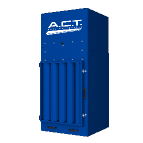 When solving a dust problem, industrial dust collector parts are somewhat of an afterthought. Truth is, they’re an important factor in determining the true cost of running a dust collector.
When solving a dust problem, industrial dust collector parts are somewhat of an afterthought. Truth is, they’re an important factor in determining the true cost of running a dust collector.
In this blog, we’ll discuss three ways in which industrial dust collector parts affect dust collector efficiency.
Industrial Dust Filter Change-Outs
Industrial dust filters are key to the performance of a dust collection system, but it can be difficult to know when to change them and what type of filters to use. The lifespan of different filters can vary based on the application in which dust is being collected, as well as the type of filter being used.
Many different methods can be used to determine when dust collector filters should be replaced. From simple observations to reading a gauge, it will become more apparent when the time is right to change filters.
When it is time to purchase replacement filters, OEM replacement filters last significantly longer than the aftermarket options available. Another thing to consider when purchasing filters is the minimum efficiency reporting value (MERV) ratings.
How Filters Affect Dust Collector Efficiency
Industrial dust filter change-outs are necessary for the dust collector to operate at optimum efficiency. When the filter is full of dust, air can’t flow as easily, making the dust collector work harder and become less efficient. When the filters are new and clean, air can flow more effectively through the filter as it catches the dust particles. As a result of filter change-outs and regular maintenance, the dust collector will operate with less energy and more efficiency, saving both time and money.
Choosing the Correct Blower or Fan
The blower or fan that makes a dust collector operate can be a variety of types. Industrial dust control fans are designed to be installed in a dust collection system to capture and control dust, smoke and fume. Some of the fans or blowers work better than others on certain applications.
Keep in mind that when choosing a fan or blower for your industrial dust collector machine, there are features that can be added to a blower that help it to perform effectively.
How the Blower Affects Dust Collector Efficiency
The blower or fan on a dust collector directly relates to how efficient that dust collector is. The size or cubic feet per minute (CFM) rating of the blower helps to determine the air-to-cloth ratio that the dust collection system is running. If the size of the blower is proportional to the amount of filter media area, the industrial dust filters will last longer and the blower will operate at a sustainable rate. Thus, the dust collector will be more efficient.
The Importance of Variable Frequency Drives
Variable frequency drives (VFDs) regulate the airflow as needed. This is accomplished by changing the motor frequency (speed) to regulate airflow as needed. Electrical costs will be reduced due to the lower amp draw at start up as well as the ability to reduce the speed of the fan according to filter conditions and changes in process or cubic feet per minute (cfm) requirements.
How a VFD Affects Dust Collector Efficiency
VFDs are important in ensuring a dust collector operates as efficiently as possible. VFDs regulate the amount of air that flows through the fan to help control the current draw, making the dust collector more efficient. With VFDs installed, there are minimal charges for spikes in electricity bills. VFDs can make a substantial difference in the utility costs to run a dust collection system.
Want to Make Your Dust Collector More Efficient?
While industrial dust collector parts such as filters, blowers and VFDs may seem insignificant when purchasing a dust collector or solving an immediate dust collection need, they greatly impact the efficiency of the system.
A.C.T. Dust Collectors offers solutions for all dust collection needs and will assist with making sure your dust collection system operates efficiently.



























%20Collectors%20Image.png?width=143&height=143&name=ADC%20(Ambient)%20Collectors%20Image.png)




























.png?width=240&height=91&name=ACT%20Dust%20Collectors%20Logo%20Solid%20White%202020%20(1).png)
.png?width=148&height=149&name=usa-manufactured-dust-collectors%20(1).png)